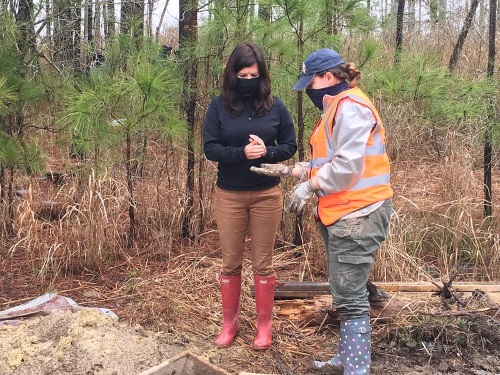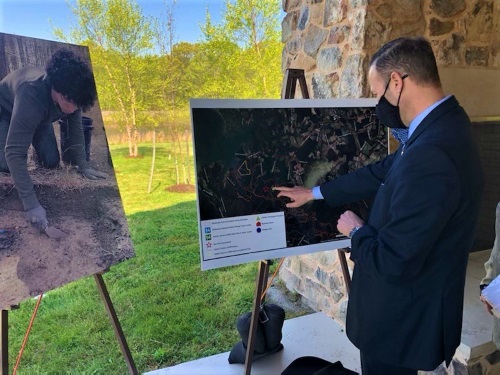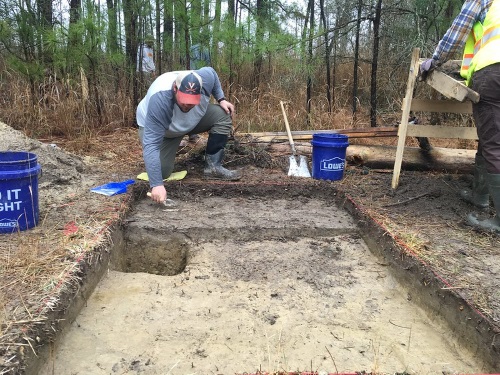“Trying and laborious” perhaps best describes the months-long research and digging conducted in search of the home of a young Harriett Tubman by the Maryland Department of Transportation’s State Highway Administration in the Blackwater Wildlife Refuge on Maryland’s Eastern Shore.
[Above photo by the Maryland DOT]
In 2019, the U.S. Fish and Wildlife Service (USFWS) purchased the 2,600-acre Peter’s Neck site within that refuge for $6 million – an area where historians thought Tubman’s childhood home might be located. That is why a year later, Marcia Pradines – the Chesapeake Marshlands National Wildlife Refuge complex project leader for the USFWS – asked the Maryland DOT for archeological help in potentially uncovering the young Tubman’s home.
“I asked the state for assistance when I learned they had the interest and capacity to do so,” Pradines said. “It’s been a wonderful partnership.”
Tubman – born in 1822 and originally named Araminta Ross – was an escaped slaved who became one of the most famous American abolitionists and political activists. She used a network of antislavery activists and safe houses known as the Underground Railroad to transport freed slaves to Northern states and served as an armed scout and spy for the Union Army during the American Civil War.

While Tubman’s years as an abolitionist, spy, and later as a women’s suffrage activist are well known, relatively little is about her childhood.
That all changed in November 2020 due to the persistent efforts of a Maryland DOT SHA research team.
The extensive digging in the muck by the Maryland DOT SHA crew at the Peter’s Neck site turned up a coin from 1808; specifically a 50-cent “Liberty” coin. Then the archelogy crew discovered a chip from a broken ceramic piece, soon followed by other small artifacts.
After a lull in the project, Maryland DOT SHA researchers returned to the site – a one-time timber farm that had now become marshlands – in March 2021 to continue digging, finally striking pay dirt: the remains of the Ben Ross home, so named for Tubman’s father, still relatively intact. Tubman lived on the site with her family; a place where she began learning how to navigate what became known as the Underground Railroad.
Julie Schablitsky, chief of the Cultural Resources Division for Maryland DOT, explained during a recent press event that she and her crew heard about the potential location of the Ross cabin at the Peter Neck’s site just before COVID-19 hit. After the USFWS asked for their assistance, her team got busy: donning mosquito netting and rubber boots to dig away in the swampland to see if remains of Tubman’s home could be found.
“It was very wet, very foggy and very muddy” digging the five-foot-by-five-foot holes, Schablitsky explained – all in an effort to find what turned out to be archeological gold.
This chapter of Tubman’s story began with plantation owner Anthony Thompson leaving the enslaved Ross 10 acres (known as “Ben’s 10”) in his will. That act gave the Maryland DOT SHA team some idea where the house was.

The team dug “hole and hole after hole,” said Schablitsky, and eventually found that coin from 1808 – the approximate year “when Tubman’s parents were married,” she noted. “Then we found the bits of ceramics.”
When the Maryland DOT SHA crew returned in early spring this year, they resumed digging and found more artifacts, including furniture and other housewares. While small, those bits and pieces equate to the bigger story, Schablitsky pointed out that the real question is, “How do we learn more? Sometimes the answer is archaeology.”
Her team continues learning more of the cabin site, which “about 20 to 25 percent” excavated, she said. It lies in a scenic area near Harrisville Road, an area today surrounded by woods and extensive waterfalls. Historically, it would have been in a wooded area not accessible by water.
With the refocus on Tubman heightening the public’s interest, the current state of the site makes for what Schablitsky termed “a treacherous journey,” including about a one-mile walk through knee-deep water to reach the site. However, there are “creative ways” to make it accessible for pedestrians. “We have a trail laid out and are looking for funding,” she said.
The descendants of the Tubman family are equally excited about the findings and what the future may hold for them.

Tina Wyatt, Tubman’s great-great-great-grandniece and Ross’ great-great-great-great-granddaughter, spoke for the family at the press event.
“[The news] brings enlightenment, revealing how [Ross] lived his daily life, making it a real-life connection to and for me,” Wyatt said. “The world benefits also from the study of these artifacts concerning objects used by the enslaved; are they common to this plantation, to his position or to this region? It gives us so much more to explore, explain and exhibit.”
As for the site and the artifacts, she added that what has been found looks “Pretty much untouched from when the family was there,” Wyatt noted, emphasizing that Tubman “embraced not the circumstances, but the environment.
“For something so horrific [as slavery to happen] to her people,” Wyatt said. “It’s great to be there now.”
Plans for tourists and historians who want to visit the site are being discussed, said USFWS’s Pradines, as Maryland DOT archeologists plan to return to the dig for further excavation in late fall or spring 2022.
Establishing a timeline for the preservation of the property is critical as well, for the Ross cabin resides in an area predicted to naturally convert to marsh with parts remaining forested into the year 2100.
With the cost to open the approach and the site to the public hovering around an estimated at $200,000 – getting tour buses in could make it a multi-million dollar job – Pradines spoke of establishing a trail system with Maryland’s Department of Natural Resources and the National Park Service.
“We want to honor those stories and create new ones for birders, hunters and tourists,” she noted.
“This land has rich stories to tell,” Pradines pointed out, from the days of the Native Americans to the Ross family to the first state forester. “We want people to visit [and] we also want to preserve to the integrity of the site,” she said.

